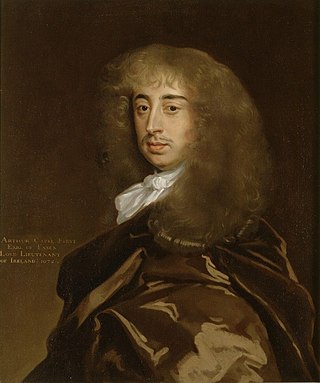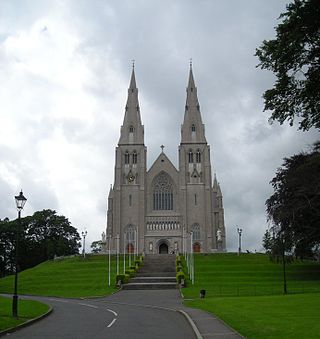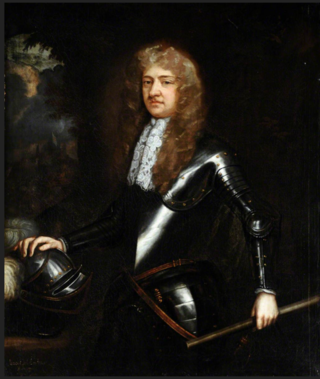
Lieutenant-General James FitzThomas Butler, 1st Duke of Ormond, KG, PC, was an Anglo-Irish statesman and soldier, known as Earl of Ormond from 1634 to 1642 and Marquess of Ormond from 1642 to 1661. Following the failure of the senior line of the Butler family, he was the second representative of the Kilcash branch to inherit the earldom.

Arthur Capell, 1st Earl of Essex, PC, also spelt Capel, of Cassiobury House, Watford, Hertfordshire, was an English statesman.

Titus Oates was an English priest who fabricated the "Popish Plot", a supposed Catholic conspiracy to kill King Charles II.

Anthony Ashley Cooper, 1st Earl of Shaftesbury PC, FRS, was an English statesman and peer. He held senior political office under both the Commonwealth of England and Charles II, serving as Chancellor of the Exchequer from 1661 to 1672 and Lord Chancellor from 1672 to 1673. During the Exclusion Crisis, Shaftesbury headed the movement to bar the Catholic heir, James II, from the royal succession, which is often seen as the origin of the Whig party. He was also a patron of the political philosopher John Locke, with whom Shaftesbury collaborated with in writing the Fundamental Constitutions of Carolina in 1669.

The Popish Plot was a fictitious conspiracy invented by Titus Oates that between 1678 and 1681 gripped the kingdoms of England and Scotland in anti-Catholic hysteria. Oates alleged that there was an extensive Catholic conspiracy to assassinate Charles II, accusations that led to the executions of at least 22 men and precipitated the Exclusion Bill Crisis. During this tumultuous period, Oates weaved an intricate web of accusations, fueling public fears and paranoia. However, as time went on, the lack of substantial evidence and inconsistencies in Oates's testimony began to unravel the plot. Eventually, Oates himself was arrested and convicted for perjury, exposing the fabricated nature of the conspiracy.

Arthur Annesley, 1st Earl of Anglesey PC was an Anglo-Irish royalist statesman. After short periods as President of the Council of State and Treasurer of the Navy, he served as Lord Privy Seal between 1673 and 1682 for Charles II. He succeeded his father as 2nd Viscount Valentia in 1660, and he was created Earl of Anglesey in 1661.

Oliver Plunkett was the Catholic Archbishop of Armagh and Primate of All Ireland and the last victim of the Popish Plot. He was beatified in 1920 and canonised in 1975, thus becoming the first new Irish saint in almost seven hundred years.

Richard Talbot, 1st Earl of Tyrconnell, was an Irish politician, courtier and soldier.

William Herbert, 1st Marquess of Powis, KG, PC (1626 – 2 June 1696) was an English nobleman, best remembered for his suffering during the Popish Plot. He succeeded his father as 3rd Baron Powis in 1667 and was created Earl of Powis in 1674 by King Charles II and Viscount Montgomery, of the Town of Montgomery, and Marquess of Powis in 1687 by King James II, having been appointed to the Privy Council in 1686.

The Archdiocese of Armagh is a Latin ecclesiastical territory or archdiocese of the Catholic Church located in the northern part of Ireland. The ordinary is the Roman Catholic Archbishop of Armagh who is also the Metropolitan of the ecclesiastical province of Armagh and the Primate of All Ireland. The mother church is St Patrick's Cathedral. The claim of the archdiocese to pre-eminence in Ireland as the primatial see rests upon its traditional establishment by Saint Patrick circa 445. It was recognised as a metropolitan province in 1152 by the Synod of Kells.

Irish Catholic Martyrs were 24 Irish men and women who have been beatified or canonized for both a life of heroic virtue and for dying for their Catholic Faith between King Henry VIII and Catholic Emancipation in 1829.
Events from the year 1680 in Ireland.
Events from the year 1678 in Ireland.
Thomas Fleming (1593–1665) was an Irish Franciscan and Roman Catholic Archbishop of Dublin; he was entitled to hold the title Baron Slane, but renounced it.

Richard Butler, 1st Earl of Arran (1639–1686) was Lord Deputy of Ireland from 1682 to 1684 while James Butler, 1st Duke of Ormonde, his father, the Lord Lieutenant, was absent in England. He sat in the Irish House of Lords as Earl of Arran and in the English one as Baron Butler of Weston. When William Howard, 1st Viscount Stafford was accused of treason during the Popish Plot, Arran braved the anti-Catholic hysteria and voted not guilty.

The Exclusion Bill Parliament was a Parliament of England during the reign of Charles II of England, named after the long saga of the Exclusion Bill. Summoned on 24 July 1679, but prorogued by the king so that it did not assemble until 21 October 1680, it was dissolved three months later on 18 January 1680/81.
Patrick Russell was an Irish Roman Catholic prelate. He was Archbishop of Dublin from August 1683 until his death, having been imprisoned owing to his support for Jacobitism.
Events from the year 1669 in Ireland.
Sir William Talbot, 3rd BaronetPC (Ire) was the last of the Talbot baronets of Carton: his title was forfeited on account of his loyalty to King James II of England. He was an Irish politician and judge, who served briefly as Master of the Rolls in Ireland.
Peter Creagh or Piers Crevens was an Irish Roman Catholic bishop in the late 17th and early 18th centuries.













